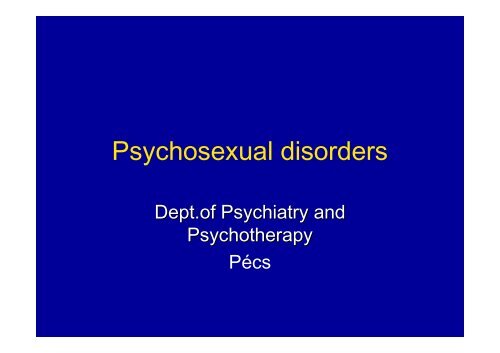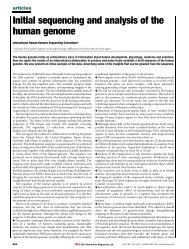Psychosexual disorders
Psychosexual disorders
Psychosexual disorders
You also want an ePaper? Increase the reach of your titles
YUMPU automatically turns print PDFs into web optimized ePapers that Google loves.
<strong>Psychosexual</strong> <strong>disorders</strong><br />
Dept.of Psychiatry and<br />
Psychotherapy<br />
Pécs
Krafft-Ebing<br />
(1840-1902)
Sigmund Freud
Three categories of sexual<br />
<strong>disorders</strong><br />
• Sexual dysfunctions - disturbance of sexual<br />
arousal or sexual performance<br />
• Paraphilias - culturally inappropriate or dangerous<br />
pattern of sexual arousal e.g.exhibicionism –<br />
• „sexual deviation”<br />
• Sexual identity <strong>disorders</strong> - dissatisfaction with<br />
own’s biological sex, a desire to become a member<br />
of the opposite sex (e.g. transsexualism)
Sexual dysfunctions<br />
Phases<br />
• Desire<br />
• Excitement<br />
• Orgasm<br />
• Resolution<br />
Dysfunction<br />
Hypoactive sexual desire disorder; sexual aversion<br />
disorder; hypoactive sexual desire disorder due to a<br />
general medical condition (male or female); substanceinduced<br />
sexual dysfunction with impaired desire<br />
Female sexual arousal disorder; male erectile disorder<br />
(may also occur in stage 3 and in stage 4); male erectile<br />
disorder due to a general medical condition; dyspareunia<br />
due to a general medical condition (male or female);<br />
substance-induced sexual dysfunction with impaired<br />
arousal<br />
Female orgasmic disorder; male orgasmic disorder;<br />
premature ejaculation; other sexual dysfunction due to a<br />
general medical condition (male or female); substanceinduced<br />
sexual dysfunction with impaired orgasm<br />
Postcoital dysphoria; postcoital headache
Sexual Dysfunction Not Correlated with<br />
Phases of the Sexual Response Cycle<br />
Category<br />
• Sexual pain<br />
<strong>disorders</strong><br />
• Other<br />
Dysfunctions<br />
Vaginismus (female) Dyspareunia (female<br />
and male)<br />
Sexual dysfunctions not otherwise specified.<br />
Examples:<br />
1. No erotic sensation despite normal<br />
physiological response to sexual stimulation<br />
(e.g., orgasmic anhedonia)<br />
2. Female analogue of premature<br />
ejaculation<br />
3. Genital pain occurring during<br />
masturbation
Diagnostic Criteria for Sexual Dysfunction<br />
Due to a General Medical Condition<br />
A. Clinically significant sexual dysfunction that<br />
results in marked distress or interpersonal<br />
difficulty predominates in the clinical picture.<br />
B. There is evidence from the history, physical<br />
examination, or laboratory findings that the<br />
sexual dysfunction is fully explained by the direct<br />
physiological effects of a general medical<br />
condition.<br />
C. The disturbance is not better accounted for by<br />
another mental disorder (e.g., major depressive<br />
disorder).
Diagnostic Criteria for Sexual Dysfunction<br />
Female hypoactive sexual desire disorder : if deficient or<br />
absent sexual desire is the predominant feature.<br />
• Male hypoactive sexual desire disorder if deficient or<br />
absent sexual desire is the predominant feature.<br />
• Male erectile disorder if male erectile dysfunction is the<br />
predominant feature.<br />
• Female dyspareunia : if pain associated with intercourse is<br />
the predominant feature.<br />
• Male dyspareunia : if pain associated with intercourse is<br />
the predominant feature.<br />
• Other female sexual dysfunction : if some other feature is<br />
predominant (e.g., orgasmic disorder) or no feature<br />
predominates.<br />
• Other male sexual dysfunction if some other feature is<br />
predominant (e.g., orgasmic disorder) or no feature<br />
predominates.
Neurotransmitter Effects on Sex Function<br />
Dopamine Serotonin Adrenergic Cholinergic<br />
Erection ++ +/- α, β +/-<br />
- +<br />
Ejaculation +/- + + +/-<br />
and orgasm α 1
Etiological factors<br />
• Biological, medical illnesses<br />
• general medical conditions<br />
• Substances use dependency<br />
• Psychological (learning, analytical, -<br />
traumas, communication failure)<br />
• drugs – side effects<br />
• E.g
Paraphilias<br />
• Pedophilia<br />
• Exhibitionism<br />
• Voyeurism<br />
• Frotteurism<br />
• Sexual masochism<br />
• Transvestic<br />
fetishism<br />
• Sexual sadism<br />
• Fetishism<br />
• Zoophilia<br />
•Coprophilia<br />
•Urophilia<br />
•Telephon scatologia<br />
•Computer scatologia<br />
•Necrophilia
Gender identity <strong>disorders</strong> I.<br />
• Gender identity disorder<br />
– Transsexualism<br />
– Adolescent/adult gender identity disorder<br />
– Childhood gender identity disorder
Gender identity <strong>disorders</strong> II.<br />
• Gender identity disorder NC<br />
– Intersexual <strong>disorders</strong> (etc.: androgen<br />
resistency, congenital adrenal hyperplasia)<br />
and related discomfort<br />
– Transient, stress-related cross-dressing
Some aspects of the therapy<br />
• Drugs – if needed /symptomatology, general th, viagra.<br />
cialis, anxiolytics e.g./<br />
• Dual sex therapy – both partners<br />
• Review of the psychological and psyciological aspects of<br />
sexual functioning and an evalution of the couple’s<br />
attitudes about sexual<br />
• ability to communicate<br />
• suggestion are made for specific sexual activity<br />
• sexual relations are emphasized as natural and healthy<br />
• relatively briet sex therpay (i.e.,8-12)<br />
• focuses correcting dysfunctional behavior, not on<br />
interpreting<br />
• exersises may focus on increasing sensory awareness<br />
of erogenuos zones, so that couples can leart to give<br />
and receive bodily pleasure (i.e.”sensate focus”).
Thank you for attention !

















